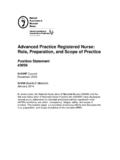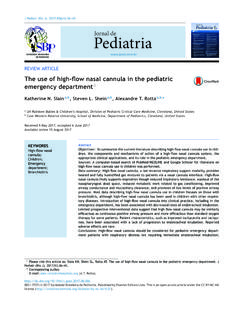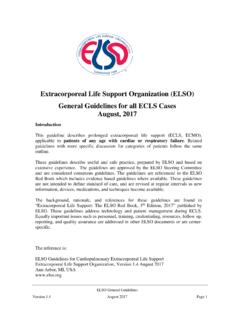Transcription of The Management of Hypotension in the Very-Low …
1 The Management of Hypotension in the Very-Low -Birth-Weight Infant Guideline for PracticeEndorsed byPublisher s note. The National Association of Neonatal Nurses (NANN), the authors, and the editors neither represent nor guarantee that the content will, if followed, ensure the delivery of safe and effective patient care. NANN assumes no liability or responsibility in connection with the content. The content reflects NANN s judgment regarding the state of general knowledge and practice in this field as of the date of publication and is subject to change on the basis of the availability of new scientific information. The content is not intended to be a substitute for professional medical judgment, diagnosis, or content of The Management of Hypotension in the Very-Low -Birth-Weight Infant: Guideline for Practice is to be used only for individual review and study.
2 For any other use, written permission to use or reprint the content must be obtained. All requests for such use must be made in writing and addressed to the National Association of Neonatal Nurses, 4700 W. Lake Avenue, Glenview, IL 2011 National Association of Neonatal Nurses. All rights reserved under and international copyright laws. Reproduction, distribution, or translation without express written permission is strictly W. Lake Avenue, Glenview, IL Fax Management of Hypotension in the Very-Low -Birth-Weight Infant 3 ContentsAbstract ..4 Focus ..4 Developers ..4 Funding Source or Sponsor ..4 External Reviewers ..4 Objective ..5 Users and Setting ..5 Target Population ..5 Evidence Collection Methods ..5 Recommendations and Grading Criteria ..5 Method for Synthesizing Evidence ..5 Prelease Review ..5 Definitions.
3 5 Recommendations and Rationale ..5 Patients Preferences ..9 Potential Benefits and Harms ..9 Algorithm ..10 Implementation Considerations ..11 Outcome Review Criteria ..11 Update Plan ..11 References ..124 National Association of Neonatal Nurses PractitionersAbstractThis guideline, released in 2011, focuses on the clinical Management of systemic Hypotension in the Very-Low -birth-weight (VLBW) infant during the first 3 days of postnatal Management of systemic Hypotension in the VLBW infant during the first week of postnatal life is one of the signifi-cant challenges that clinicians face. This guideline focuses on the clinical Management of Hypotension primarily during the first 3 postnatal days following a diagnosis of Hypotension as established by generally accepted criteria for that diagnosis (see Definitions ).DevelopersLyn Vargo, PhD RN NNP-BCIstvan Seri, MD PhDFunding Source or SponsorNational Association of Neonatal Nurses (NANN) and National Association of Neonatal Nurse Practitioners (NANNP)External ReviewersRobin L.
4 Bissinger, PhD APRN NNP-BC, College of Nursing, Medical University of South Carolina, Charleston, SCEdward Schwarz, MD, St. John s Mercy Medical Center, St. Louis, MORebecca Siewert, DNP RN NNP-BC, University of Iowa College of Nursing and University of Iowa Children s Hospital, Iowa City, IACarol Trotter, PhD RN NNP-BC, University of Missouri Kansas City, Kansas City, MOThe Management of Hypotension in the Very-Low -Birth-Weight Infant 5 ObjectiveTo provide an evidence-based clinical guideline for the Management of systemic Hypotension in VLBW infants during the first 3 days of postnatal lifeUsers and SettingNeonatologists, neonatal nurse practitioners (NNPs), and nurses in neonatal intensive care units (NICUs)Target PopulationPremature infants born at 1,500 grams or less and less than 3 postnatal days oldEvidence Collection MethodsEvidence was collected via searches of three electronic databases Medline, Neonatal Cochrane Collaboration, and Cumulative Index to Nursing and Allied Health Literature (CINAHL) from 2000 to 2010.
5 Search words included hy-potension, blood pressure, systemic blood flow, premature infant, and very low birth weight and Grading CriteriaThe following grading system was employed to rate the quality and strength of the evidence to support the practice recommendations:Rating System for the Hierarchy of EvidenceLevel I: Evidence from a systematic review or meta-analysis of all relevant randomized controlled trials (RCTs) or evidence-based clinical practice guidelines based on systematic reviews of RCTsLevel II: Evidence obtained from at least one well-designed RCTL evel III: Evidence obtained from well-designed controlled trials without randomizationLevel IV: Evidence from well-designed case-control and cohort studiesLevel V: Evidence from systematic reviews of descriptive and qualitative studiesLevel VI: Evidence from a single descriptive or qualitative studyLevel VII: Evidence from the opinion of authorities or reports of expert committeesFrom Evidence-Based Practice in Nursing and Healthcare: A Guide to Best Practice (p.)
6 10), by B. M. Melnyk & E. Fineout-Overholt, 2005, Philadelphia: Lippincott Williams and Wilkins. Copyright 2005 by Lippincott Williams and Wilkins ( ). Reprinted with for Synthesizing EvidenceEvidence tables and decision analysis using levels of evi-dence were used to construct the guideline. The opinions of experts were used when firm evidence documented by research was not ReviewExternal reviewers and neonatal cardiovascular experts were asked to review the evidence with attention to clarity prior to the guideline s following definitions were used in formulating the guideline: Hypotension Experts believe that three different levels of functional alteration in the VLBW infant can be used to refine the definition of Hypotension : a loss of vital organ blood flow autoregulation, a loss of function, and a loss of tissue integrity (ischemic threshold).
7 1 However, many unanswered questions remain regarding the determination of the specific blood pressure values that indicate pathology in VLBW infants within each level. In addition, it is unclear how to determine the specific blood pressure parameters that affect morbidity, mortality, and long-term outcome in the VLBW general neonatal practice the two most common pa-rameters used to define Hypotension during the immediate transitional period are a blood pressure that falls below a mean arterial pressure (MAP) of 30 mm Hg or a MAP with a number lower than the infant s gestational age in weeks. These values will be used to define Hypotension during the first 3 days of postnatal life because evidence exists that beyond this period, more than 90% of VLBW infants with gestational ages of 23 26 weeks will have a MAP greater than In addition, beyond this period the pathophysiology of Hypotension is less likely to be affected by ductal and fora-men ovale shunting, and this fact should be considered when one is treating Hypotension beyond postnatal day 3.
8 However, these definitions are primarily based on principles of developmental cardiovascular physiology and thus represent a rather simplistic and, at present, mostly non-evidence-based interpretation of what actually constitutes Hypotension with clinically relevant consequences in the human (VLBW) infant a premature infant weighing less than 1,500 grams at systemic blood flow (LSBF) the condition exist-ing when a decreased amount of blood reaches systemic end organs, resulting in decreased oxygen delivery to the organs and the development of and RationaleThe topic of Hypotension and its treatment in the VLBW infant is complex. Our understanding of what constitutes Hypotension in this population and our ability to effectively monitor hemodynamic changes at the level of tissue perfu-sion and organ blood flow remains limited.
9 Although it is true that we can normalize blood pressure, it has become evident that blood pressure is only one of many compo-nents that determine overall tissue perfusion and thus oxygen delivery in VLBW Although neonatal care is often aimed at avoiding Hypotension , it may be that caregiv-ers need to be more concerned instead with preventing the consequences of our discussion of the Management of Hypotension in the VLBW infant, it is critical that we include an understand-ing of the infant s presenting diagnosis, the intricacies 6 National Association of Neonatal Nurses Practitionersof the transition from fetal to transitional circulation, the importance of ductal and foramen ovale shunting during the first days of postnatal life, factors affecting cerebral hemo-dynamics such as pH and carbon dioxide tension in the first postnatal days, systemic vasodilation and vasoconstriction, levels of systemic blood flow (cardiac output), and the inter-action between systemic and cerebral hemodynamics.
10 For example, systemic blood flow in some VLBW infants during the first 6 12 hours of postnatal life, assessed by superior vena cava (SVC) blood flow, is low, and blood pressure values may not identify this The decrease in sys-temic blood flow that occurs during this period is thought to be related to the decreased ability of the immature myo-cardium to pump against the suddenly increased systemic vascular resistance that occurs following cord clamping and removal of the low-resistance LSBF will improve as transition progresses and as the systemic blood flow ( , SVC flow) normalizes in VLBW infants by 36 hours of postnatal ,6 However, use of the measurement of SVC blood flow as a measure of systemic blood flow in VLBW infants has limitations, as does the measurement of another factor that is often used in neonatology, measurement of left ventricu-lar output.











